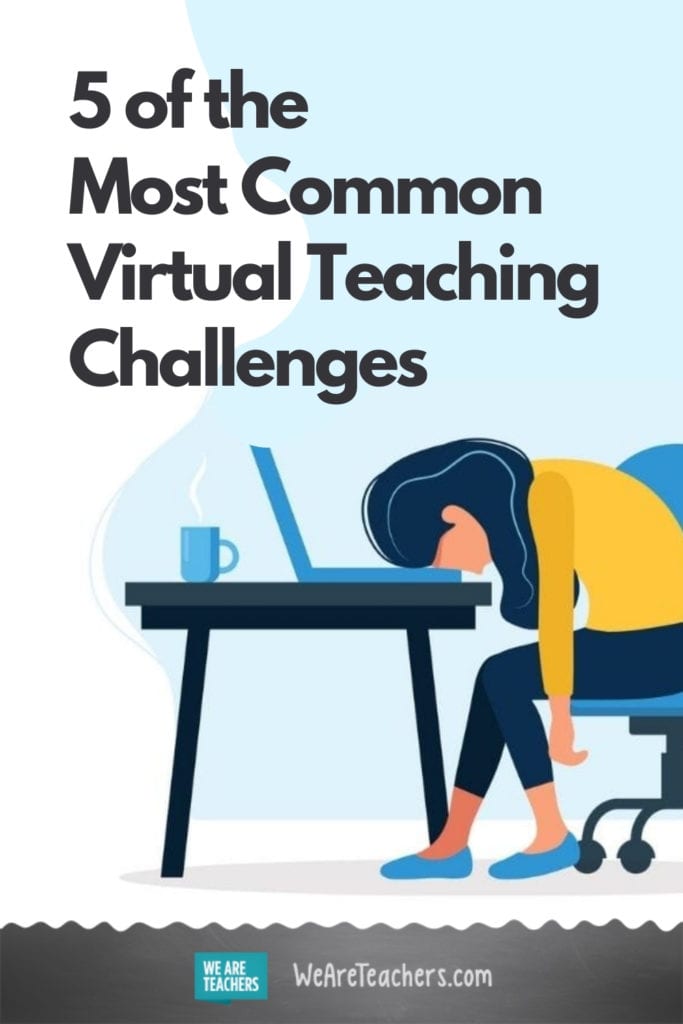After six months of virtual teaching, many of us have success stories to share, but we’ve all encountered some big challenges too. Below, we’ve rounded up some of the most common virtual teaching issues we’ve seen in our WeAreTeachers HELPLINE group on Facebook, along with teacher advice on how to solve them.
Challenge #1: Frozen screens and tech problems galore
One of the most common frustrations is the hot mess of tech issues that come with trying to get thirty kids on the same call. Sometimes this happens at home, and sometimes as part of a partially live-streamed classroom. Even taking attendance can be a ten-minute process as students join and leave the call for various reasons, some including technical difficulties.
If your district has a process for handling student Wi-Fi issues, start there. Make yourself a cheat sheet of how to submit a tech ticket, concrete steps to try with the student on your own, and other tips they have provided. If your district doesn’t offer it, start building in 5-10 extra minutes per class period to account for frozen screens and Zoom kicking students off the call. Create a procedure for what to do if you or the student loses connection, and clearly communicate and post this for the students. Examples include:
- Email the teacher and/or tech support person a screenshot of what the student is experiencing after they are kicked off
- Ask a frozen student to contribute via the chat function
- Provide a standing alternate assignment students can complete independently if the call continues to not work for them
- If the teacher has tech issues, wait a certain amount of time (defined ahead of time) before logging off the call
[contextly_auto_sidebar]
Challenge #2: Muting and unmuting
In one of our first classes back to school, my students spent a full minute practicing the “control D” function for muting and unmuting themselves on Google Hangout/Meet. For some, this shortcut was enough to learn how to do it. For others, we still struggle with long delays as they get close and squint to find the unmute or mute button. It’s one of my consistent virtual teaching issues!
While it seems small, this 10-20 second delay times a million per day leads to some frustrating communication and disrupted conversation flow. Periodically practicing the mute and unmute function as a class, regardless of age group, can help refresh their memories. It also prevents the whole class from hearing surprise situations happening behind the scenes in a student’s home. Also, keep your own mouse ready to mute kids yourself. This is often quicker than asking them to mute themselves.
Challenge #3: Some students are dominating the conversation, others are MIA
Somehow we’ve conquered balancing conversations in person, but virtual learning is a new game. All of a sudden, that student who answers too much can just unmute himself and talk without raising a hand. In order to equalize the contributions of all the classmates, consider setting guidelines for how often one student can talk out into the meeting. Or refer them to the chat to contribute additional ideas. This allows you to hear other students’ opinions.
Like in the live classroom, it can difficult to get more reserved students to engage. But chat helps there too! Sometimes the chatbox is the perfect avenue to hear from these students while preventing long and awkward pauses in the lesson. Simply saying, “Hey Joe, can you let us know in the chat what you think about XYZ? We’ll check back soon for your opinion.” Then you have the perfect springboard to engage in conversation with Joe once he’s typed his thoughts. Breakout rooms can also help more reserved kids speak when the full class is too intimidating. Like all the college and career readiness skills we’ve had to teach, including soft skills like communication norms, Zoom chats are just another one that we have to explicitly explain to kids. After all, they are new at this too.
Challenge #4: Do I require video or not?
The heated debate about whether to require kids to keep their video on or not continues. Some teachers say it’s not fair to require it, and have come up with ways to engage students anyway. Others say it’s necessary for nonverbal feedback and to get to know students you’ve never met. Regardless of your stance, teaching to a sea of blank screens can be draining. It can leave you struggling to connect with your students the way you did in person.
Understandably, some kids are nervous about camera use. Try having students build up to turning it on by asking them to use a picture of themselves in their profile image when their video is off. This will help teachers and classmates get to know them, rather than looking at a cat meme or videogame character. Then ask students to turn their video on just when they are talking. Over time, some of your more self-conscious students may come around to full video!
Challenge #5: Dealing with the unexpected
One teacher posted to the Facebook group: “I was in Google Meet with 89 kids and my then kitten broke in and ran right across my laptop. By walking on keys he typed MMMMMBBBB PPPFPP in the chat. By the time I caught him and apologized, 28 kids responded to him in the chat.” Dealing with these types of unexpected, and sometimes comical situations, is one of the reasons we became teachers. They happened in the live classroom, and they are still happening in the virtual classroom.
If we can remember the humor and insanity that sometimes comes with teaching a room (or Zoom) full of students at any age, we can continue to love teaching, and our students will continue to enjoy learning.
What virtual teaching issues are you facing? Share in our WeAreTeachers HELPLINE Facebook group.
Also, check out our resources here for online learning for parents and teachers.


